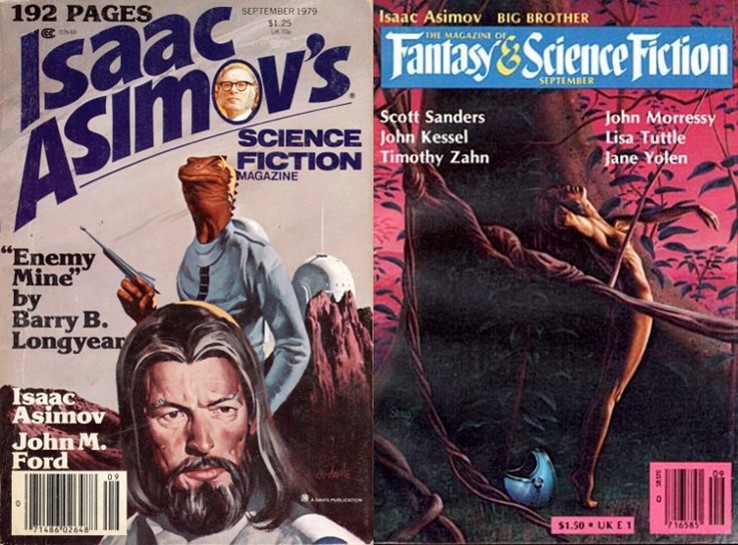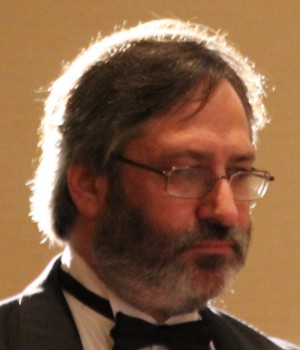Tor Doubles #6: Barry B. Longyear’s Enemy Mine and John Kessel’s Another Orphan

Cover for Another Orphan by Tom Kidd
The sixth Tor Double not only includes the two title stories, Barry B. Longyear’s Enemy Mine and John Kessel’s Another Orphan, but also includes an excerpt from Gwyneth Jones’s novel Divine Endurance. Divine Endurance was originally published in Britain in 1984 and in the U.S. as a hardcover by Arbor House in 1987. Tor was scheduled to publish a paperback edition of the novel in May of 1989, two months after this Tor Double hit the shelves. With the two title stories totaling only 158 pages, the decision was made to add a twenty page excerpt of the forthcoming novel.
Enemy Mine was originally published in Isaac Asimov’s Science Fiction Magazine in September, 1979. It won the Hugo Award and the Nebula Award, as well as the Locus poll. Enemy Mine kicked off Longyear’s “Dracon” series and was the basis for the 1985 film Enemy Mine, starring Dennis Quaid and Louis Gossett, Jr.
The year after the initial publication and success of Enemy Mine, Longyear published an extended version of the story, which has generally superseded the version that won the Hugo and Nebula Award. It is this revised version that is included in this volume.
Enemy Mine is set during a war between humans and the lizard-like Drac, both of whom see the other race as trying to impinge on their own nascent interstellar hegemonies. It is clear from the beginning that there is little communication between the races and the war has been taking place for quite some time and there is no end in sight.
When the novella begins, a human, Willis Davidge, and a Drac, Jeriba Shigan, have crashed on the planet Fyrine IV while a battle rages on in orbit above them. Seeing each other as alien and enemies, they continue in their attempts to kill each other, until they realize that the inhospitable nature of the planet means they have to work together in order to survive.
Over the course of a year, Jeriba and Davidge begin to understand each other and learn each other’s language. Jeriba taught Davidge about the Talman, the closest thing the Drac have to a religious text, as well as about their culture. The Drac are hermaphroditic and when Jeriba explains that it is expecting, the teaching opens up to the ancestor respect the Drac have for their hereditary line.
Had Longyear ended the story with the two enemies coming to terms with each other, and it is clear that Jeriba is more open to the idea of learning about humans than Davidge is with learning about the Drac, Enemy Mine would have been a typical science fiction story. However, the fact that Jeriba is expecting adds a twist to the story that elevates it.
When Jeriba dies in childbirth, it is up to Davidge to raise its child, Zammis, and protect it from the elements. Davidge does this to the best of his abilities, creating a person who is a mix of human and Drac philosophies and who loves the dangerous world upon which it was raised, even as Davidge continues to only see the dangers of Fyrine IV.
Eventually, rescue comes and Davidge finds himself back on an Earth following an armistice with the Drac. Trying to find work and living with his parents, he suffers the sort of disorientation many former soldiers find and is not fully able to fit into his society. When he realizes that despite the truce with the Drac, humans are still as prejudiced against the Drac as they had been during the war, Dravidge decides to attempt to rectify that by translating the Talman into English, although his primary goal is to earn enough money to travel to the Drac homeworld to see Zammis.
While Dravidge’s time with Jeriba and Zammis had taught him about the Drac and the philosophy espoused by the Talman, it gave him a very specific view of the Drac, specifically Jeriba’s own interpretation of Drac culture and philosophy. Upon his arrival at Draco, he learns that their society is every bit as complex and narrow minded as human society. His initial meeting with Jeriba’s father, Gothig, does not go at all as he expects and he learns that the Drac authorities can not be trusted to do the right thing.
Desptie the moment of truce following Dravidge’s rescue, it becomes clear that it is a temporary thing in Longyear’s world. The racial tensions and prejudices of the humans and Drac may be overcome on an individual basis, but they cannot be address on a societal level unless a new society, built apart from mainstream humanity or Drac culture, is allowed to be built.
Although Enemy Mine offers a roadmap to break the cycle of hatred, it does so with an understanding that it can only be done by disregarding the majority of people who may not be able to put aside the slights and atrocities, real or perceived, committed in the past.
I previously discussed Enemy Mine on September 3, 2019 as part of the “Golden Age of Science Fiction” series.

Fantasy and Science Fiction 9/82 cover by Barclay Shaw
Another Orphan was originally published in F&SF in September, 1982. It was nominated for the Hugo Award and the Nebula Award, winning the latter.
Patrick Fallon has become unstuck in time, well, perhaps not, but there is a certain feel that he has given that he wakes up one morning and instead of finding himself working at the Chicago Mercantile Exchange he is on a sailing ship, with no memories of how he got there, but clear memories of his life in Chicago and his recent argument with his girlfriend, Carol.
However, Fallon belongs on the ship. The other sailors accept him and know his name. If they question his lack of knowledge of how do the he most basic tasks on the ship, they ignore their doubts, figuring he’ll work his way through it. And he does, with a small amount of help from shipmate Bulkington.
As he begins to figure out how to handle tasks, life on board the ships begins to gain a familiarity to Fallon, but not because he remembers life on the ship. Instead he begins to realize that he hasn’t slipped through time, but instead has slipped through realities, finding himself aboard the whaling ship Pequod, as described in Herman Melville’s Moby Dick.
Having read Moby Dick, Fallon knows that in the end the ship and its crew are doomed with the exception of Ishmael, who he can’t find among the crew. Although he entertains the idea that he may be fulfilling Ishmael’s role, Fallon decides he can’t rely on that hope for survival. After talking with Ahab and learning how much the captain is focused on killing his white whale, Fallon decides he needs to take matters into his own hands.
Fallon talks to other crewmen, including Starbuck, Stubbs, and Bulkington, trying to get them all to understand that Ahab’s focus threatens them all. While they may agree with Fallon, they also understand their place aboard the ship and can’t fathom the idea of mutiny, which is the only way to accomplish the action Fallon is calling for.
Even as he acclimatizes to life on board the Pequod, Fallon recalls his life in Chicago and yearns to return to the comfort and safety of life as a trader. His wife appears to be granted when he suddenly finds himself back in Chicago, preparing for a day of work, and finding that he is as lost there as he was when he first awoke on the Pequod. However, His two lives bleed into each other and Fallon realizes that whether he is in Chicago or the Pequod, the crew he has been living with are moving toward the inexorable climax of the novel which seemingly means Fallon’s death as well as the rest of the crew, with the exception of the enigmatic and undiscovered Ishmael.
Kessel appears to be having fun torturing his main character and the reader by showing them the parallels between the Pequod of Moby Dick and the Pequod of Another Orphan. Because the novel was written by Melville 130 years before Kessel’s story, the events of the story would seem to be set, but Kessel subverts that with the ideas, put forth by both Fallon and Ahab, that events can be fluid and are not predestined. While Fallon is hopeful that the destiny he sees can be averted, Ahab sees an outcome that involves the death of Moby Dick, but doesn’t necessarily mean the destruction of his ship or crew, and until that occurs, the results are undecided.
Fallon’s story is not neatly wrapped up. The final encounter with the whale is still in his future and Ahab is still his captain. Their future has not yet been written, but Kessel leaves them with a sense of dread that they won’t be able to avert the ending Melville has written for them and Fallon may never be able to turn his back on the Pequod and return to his life in Chicgao.
The cover for Another Orphan was painted by Tom Kidd. The cover for Enemy Mine was painted by Maren.
 Steven H Silver is a twenty-one-time Hugo Award nominee and was the publisher of the Hugo-nominated fanzine Argentus as well as the editor and publisher of ISFiC Press for eight years. He has also edited books for DAW, NESFA Press, and ZNB. His most recent anthology is Alternate Peace and his novel After Hastings was published in 2020. Steven has chaired the first Midwest Construction, Windycon three times, and the SFWA Nebula Conference numerous times. He was programming chair for Chicon 2000 and Vice Chair of Chicon 7.
Steven H Silver is a twenty-one-time Hugo Award nominee and was the publisher of the Hugo-nominated fanzine Argentus as well as the editor and publisher of ISFiC Press for eight years. He has also edited books for DAW, NESFA Press, and ZNB. His most recent anthology is Alternate Peace and his novel After Hastings was published in 2020. Steven has chaired the first Midwest Construction, Windycon three times, and the SFWA Nebula Conference numerous times. He was programming chair for Chicon 2000 and Vice Chair of Chicon 7.
Unlike the previous paired pieces of fiction this series’s editors put together and most of those it had after this, these two were an odd couple of titles and authors to put in one volume. Not to say that’s bad, just an incongruous match on the face of things. I wonder what the thinking was.
Metaluna called. They want their mutant back.
man, i love the movie Enemy Mine, but havnt looked much into reading the story, but now that i know it ends very different i might have to move it up the TBR list, thanks!